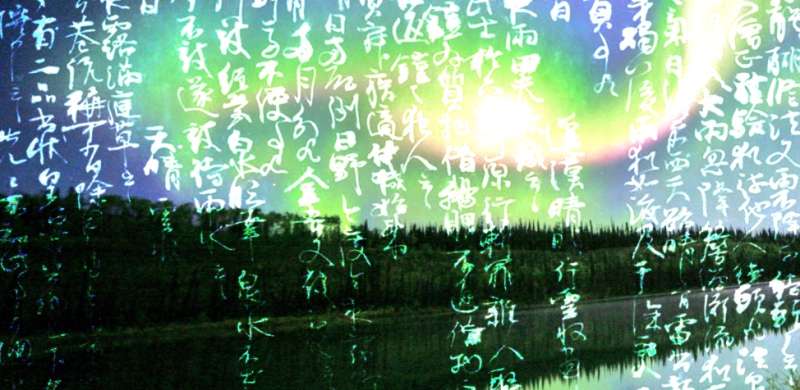Scientists reconstruct space history with ancient texts

Ice cores and ancient sediments can be gleaned for clues to weather and climate in the past. But astronomical phenomena—such as solar flares or auroras—at best leave only faint environmental traces lacking in specificity. So how can we accurately track ancient astronomical events?
Now in a collaborative effort between the arts and sciences, researchers at Kyoto University and Japan's National Institute of Polar Research (NIPR) and National Institute of Japanese Literature (NIJL) have used historical documents to garner better insight into the patterns of past solar events.
Magnetic storms recorded as auroral sightings in Meigetsuki ("The Record of the Clear Moon", ca 1180-1241) by Fujiwara no Teika of Japan, and in Song Shi ("History of Song", commissioned 1343) from China, have given researchers the ability to reconstruct a chronology of past astronomical events. Their findings appeared in the journal Space Weather.
"An early Japanese record of prolonged auroras, that is, auroras that persisted for two or more nights within one week, was documented 21-23 February 1204 in Meigetsuki," says lead researcher Ryuho Kataoka of NIPR. "At the same time in Song Shi, a large sunspot was recorded on the 21st." Such sunspots are an indication of intense magnetic activity on the sun, including solar flares.
The researchers continued their investigation by looking further into Song Shi to see if there were additional indications of auroras between the years 900-1200.
"We found about ten incidents of prolonged auroras during this period," continues Kyoto University historian Hisashi Hayakawa. "When these dates were compared with radiocarbon data from tree rings, we noted decreased levels of carbon-14—indicating increased levels of solar activity—at these same points."
The team was also able to discern that auroras were more prevalent in the maximal phase of solar cycles rather than the minimum, and that during the sun's least active cycle (1010-1050) no auroras were observed.
The multidisciplinary investigation is even casting its literary sources in a new light.
NIJL Deputy Director Tsuneyo Terashima points out that until now, high regard for Meigetsuki's author Fujiwara no Teika has centered on his role in compiling and editing such classics as the Tale of Genji and Ogura Hyakuninisshu—work in which his literary and poetic talents have been key.
"Frankly, his observations of the sky have been regarded mainly in the context of his fiction writing," explains Terashima, "and not really valued for their scientific specificity. We now realize that Meigetsuki in fact provides a lucid and accurate account of celestial conditions of the period."
A possible new understanding of classical Japanese literature may even result, expanding the cross-pollinating effects of the research.
"Combining literature, tree ring dating, and space observation, we have uncovered clear patterns in solar activity and astronomical events," says Kyoto University space scientist Hiroaki Isobe.
"In the present day, large solar storms can significantly disrupt power grids and satellites. We are ever more susceptible to solar events, and the insight gained through historical documents allows us to better predict and prepare for the future."
More information: Ryuho Kataoka et al, Historical space weather monitoring of prolonged aurora activities in Japan and in China, Space Weather (2017). DOI: 10.1002/2016SW001493
Provided by Kyoto University





















